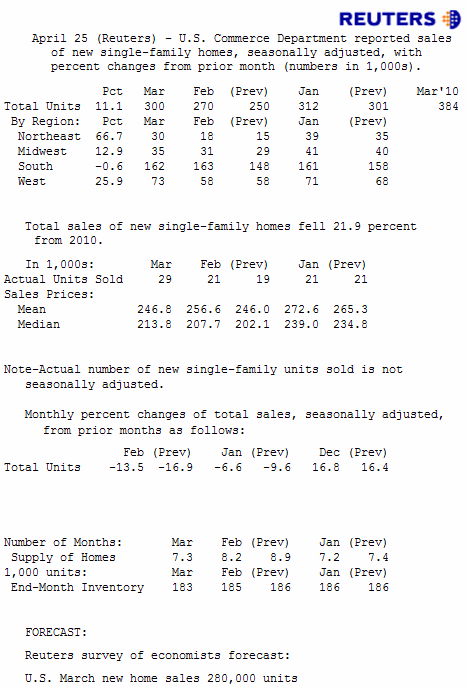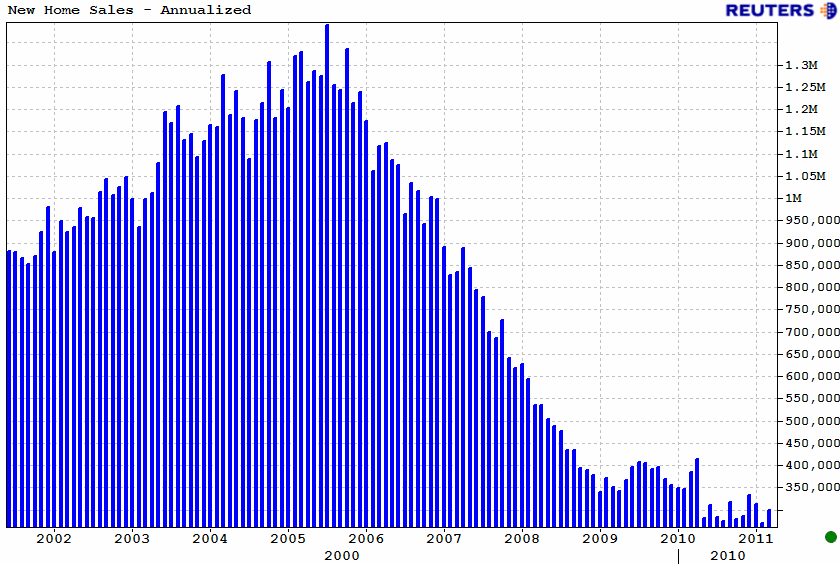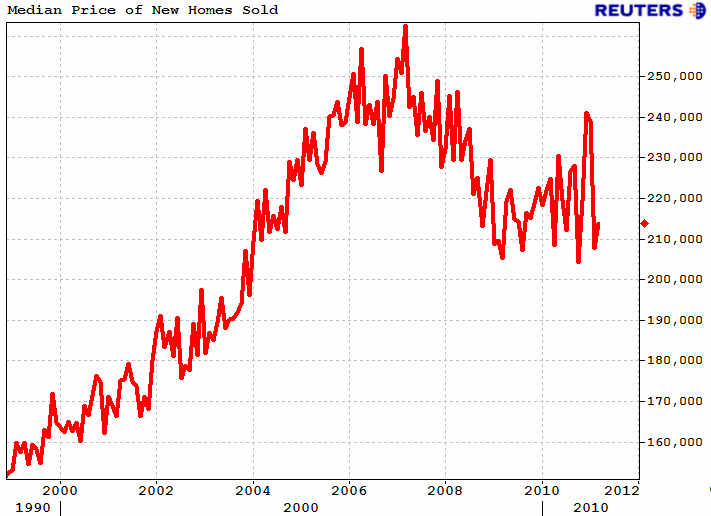Blog

New Home Sales Follow Building Permits Higher in March
The Census Bureau and Department of Housing and Urban Development havernreleased NewrnResidential Sales data for March 2011.</p<pNew Residential Sales data provides statistics on the sales of newrnprivately-owned single-family residential structures in the United States. Datarnincluded in the press release are (1) the number of new single-family housesrnsold; (2) the number of new single-family houses for sale; and (3) the medianrnand average sales prices of new homes sold.<br /<br /A house is considered sold when either a sales contract has been signed or a depositrnaccepted. Included in our estimates are houses for which a salesrncontract is signed or deposit accepted before construction has actuallyrnstarted; for instance, houses sold from a model or from plans before any workrnhas started on the footings or foundations. These estimates also includernhouses sold while under construction or after completion. This surveyrndoes not follow through to the completion ("closing") of the salesrntransaction, so even if the transaction is not finalized, the house is stillrnconsidered sold. Preliminary new home sales figures are subject to revision duernto the survey methodology and definitions used. The survey is primarily basedrnon a sample of houses selected from building permits.<br /<br /New residential sales estimates only include new single-family residentialrnstructures. Sales of multi-family units are excluded from these statistics.<br /<br /Here is a Quick Recap from Reuters…</p
RTRS – US MARCH SINGLE-FAMILY HOMErnSALES 300,000 UNIT ANN. RATE (CONS 280,000)rnVS FEB 270,000 (PREV 250,000) </p
RTRS – US MARCH SINGLE-FAMILY HOMErnSALES +11.1 PCT VS FEB -13.5 PCT (PREV -16.9 PCT) </p
RTRS – US MARCH HOME SALESrnNORTHEAST +66.7 PCT, MIDWEST +12.9 PCT, SOUTH -0.6 PCT, WEST +25.9 PCT </p
RTRS – US MARCH NEW HOME SUPPLY 7.3rnMONTHS’ WORTH AT CURRENT PACE VS FEB 8.2 MONTHS </p
RTRS – US MARCH MEDIAN SALE PRICErn$213,800, -4.9 PCT FROM MARCH 2010 ($224,800) </p
RTRS – US HOMES FOR SALE AT END OFrnMARCH 183,000 UNITS VS FEB 185,000 UNITS </p
RTRS – US MARCH HOMES FOR SALErnLOWEST SINCE AUG 1967 (181,000)</p
 </p
</p
Excerpts from the Release….</p
Sales of new single-family houses in March 2011 werernat a seasonally adjusted annual rate of 300,000, according to estimatesrnreleased jointly today by the U.S. Census Bureau and the Department of Housingrnand Urban Development. This is 11.1 percent (±21.7%)* above the revisedrnFebruary rate of 270,000, but is 21.9 percent (±10.3%) below the March 2010rnestimate of 384,000.</p
 </p
</p
The median sales price of new houses sold in Marchrn2011 was $213,800; the average sales price was $246,800. The seasonallyrnadjusted estimate of new houses for sale at the end of March was 183,000. Thisrnrepresents a supply of 7.3 months at the current sales rate.</p
 </p
</p
No surprises here. The New Home Sales survey is primarily based on a samplernof houses selected from building permits. That means we can look to Building Permits data (“Jump in Building Permits Hints at Uptick in New Home Sales”) for an indication of New HomernSales. Once again, New Home Sales followedrnthe direction of Building Permits after a decline in February.</p
Regarding the margin of error of ±21.7%:</p
More explanation from the Census Bureau: “These statistics arernestimated from sample surveys. They are subject to sampling variability as wellrnas nonsampling error including bias and variance from response, nonreporting,rnand undercoverage. Estimated average relative standard errors of thernpreliminary data are shown in the tables. Whenever a statement such as “2.5rnpercent (±3.2%) above” appears in the text, this indicates the range (-0.7 torn+5.7 percent) in which the actual percent change is likely to have occurred.rnAll ranges given for percent changes are 90-percent confidence intervals andrnaccount only for sampling variability. If a range does not contain zero, thernchange is statistically significant. If it doesrncontain zero, the change is not statistically significant; that is, it isrnuncertain whether there was an increase or decrease. The same policiesrnapply to the confidence intervals for percent changes shown in therntables.”<br /<br /TRANSLATION: Since New Home Sales in March were 11.1 percent over February with a ±21.7% standard error, thernCensus Bureau survey indicates the month over month percentage change in NewrnHome Sales was between -10.6% and +32.8% with 90% certainty. So once again we don’t know ifrnNew Home Sales improved or declined in March. The standard error is so big that itrndistorts the data…we must consider it “statisticallyrninsignificant”. When looking at the year over year comparison however, versusrnMarch 2010, the year over year chance of -21.9 percent with a ±10.3% standard error suggests arnrange of -32.2 to -11.6, which IS actually statistically significant accordingrnto the Census Bureau’s “does not contain zero” criterion. </p
All Content Copyright © 2003 – 2009 Brown House Media, Inc. All Rights Reserved.nReproduction in any form without permission of MortgageNewsDaily.com is prohibited.
Latest Articles
By John Gittelsohn August 24, 2020, 4:00 AM PDT Some of the largest real estate investors are walking away from Read More...
Late-Stage Delinquencies are SurgingAug 21 2020, 11:59AM Like the report from Black Knight earlier today, the second quarter National Delinquency Survey from the Read More...
Published by the Federal Reserve Bank of San FranciscoIt was recently published by the Federal Reserve Bank of San Francisco, which is about as official as you can Read More...

Comments
Leave a Comment